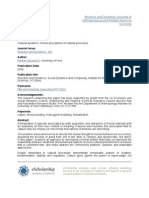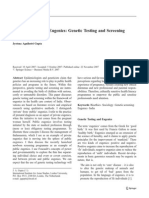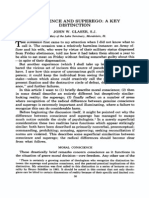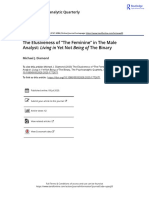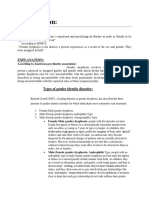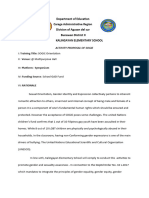The Five Sexes, Revisited
The Five Sexes, Revisited
Uploaded by
OntologiaCopyright:
Available Formats
The Five Sexes, Revisited
The Five Sexes, Revisited
Uploaded by
OntologiaCopyright
Available Formats
Share this document
Did you find this document useful?
Is this content inappropriate?
Copyright:
Available Formats
The Five Sexes, Revisited
The Five Sexes, Revisited
Uploaded by
OntologiaCopyright:
Available Formats
From: http://intranet.rutgers.edu/~quirk/fivesexes.html (See blue section below for the portion most relevant to Wheres the Proof.com.
Note also that the term five sexes was written tongue in cheek.)
The Five Sexes, Revisited
by Anne Fausto-Sterling
---------------------------------------------------------------------------[To read the article with the illustrations, go to IRIS; then to the Indexes online; then to VALE; then to Periodical Abstracts; then search for "Sciences" Jul/Aug 2000.] Abstract: As if from nowhere, intersexuals are materializing everywhere, and the boundaries separating the masculine and feminine seem harder than ever to define. This change has added another dimension to the debate on how to treat newborns of genital ambiguity. Reprinted from Sciences 40 (Jul/Aug 2000): 18-23. Copyright New York Academy of Sciences
Jul/Aug 2000
-------------------------------------------------------------------------------[IMAGE ILLUSTRATION] Captioned as: De LaGrace Volcano, Jack Unveiled, 1994 The emerging recognition that people come in bewildering sexual varieties is testing medical values and social norms. As Cheryl Chase stepped to the front of the packed meeting room in the Sheraton Boston Hotel, nervous coughs made the tension audible. Chase, an activist for intersexual rights, had been invited to address the May 2000 meeting of the Lawson Wilkins Pediatric Endocrine Society (LWPES), the largest organization in the United States for specialists in childrens hormones. Her talk would be the grand finale to a four-hour symposium on the treatment of genital ambiguity in newborns, infants born with a mixture of both male and female anatomy, or genitals that appear to differ from their chromosomal sex. The topic was hardly a novel one to the assembled physicians. Yet Chases appearance before the group was remarkable. Three and a half years earlier, the American Academy of Pediatrics had refused her request for a chance to present the patients viewpoint on the treatment of genital ambiguity, dismissing Chase and her supporters as zealots. About two dozen intersex people had responded by throwing up a picket line. The Intersex Society of North America (ISNA) even issued a press release: Hermaphrodites Target Kiddie Docs. It had done my 1960s street-activist heart good. In the short run, I said to Chase at the time, the picketing would make people angry. But eventually, I assured her, the doors then closed would open. Now, as Chase began to address the physicians at their own
convention, that prediction was coming true. Her talk, titled Sexual Ambiguity: The Patient-Centered Approach, was a measured critique of the near-universal practice of performing immediate, corrective surgery on thousands of infants born each year with ambiguous genitalia. Chase herself lives with the consequences of such surgery. Yet her audience, the very endocrinologists and surgeons Chase was accusing of reacting with surgery and shame, received her with respect. Even more remarkably, many ofthe speakers who preceded her at the session had already spoken of the need to scrap current practices in favor of treatments more centered on psychological counseling. What led to such a dramatic reversal of fortunes? Certainly, Chases talk at the LWPES symposium was a vindication of her persistence in seeking attention for her cause. But her invitation to speak was also a watershed in the evolving discussion about how to treat children with ambiguous genitalia. And that discussion, in turn, is the tip of a biocultural iceberg--the gender iceberg--that continues to rock both medicine and our culture at large. Chase made her first national appearance in 1993, in these very pages, announcing the formation of ISNA in a letter responding to an essay I had written for The Sciences, titled The Five Sexes [March/April 1993]. In that article I argued that the two-sex system embedded in our society is not adequate to encompass the full spectrum of human sexuality. In its place, I suggested a five-sex system. In addition to males and females, I included herms (named after true hermaphrodites, people born with both a testis and an ovary); merms (male pseudohermaphrodites, who are born with testes and some aspect of female genitalia); and ferms (female pseudohermaphrodites, who have ovaries combined with some aspect of male genitalia). I had intended to be provocative, but I had also written with tongue firmly in cheek. So I was surprised by the extent of the controversy the article unleashed. Right-wing Christians were outraged, and connected my idea of five sexes with the United Nationssponsored Fourth World Conference on Women, held in Beijing in September 1995. At the same time, the article delighted others who felt constrained by the current sex and gender system. Clearly, I had struck a nerve. The fact that so many people could get riled up by my proposal to revamp our sex and gender system suggested that change--as well as resistance to it--might be in the offing. Indeed, a lot has changed since 1993, and I like to think that my article was an important stimulus. As if from nowhere, intersexuals are materializing before our very eyes. Like Chase, many have become political organizers, who lobby physicians and politicians to change current treatment practices. But more generally, though perhaps no less provocatively, the boundaries separating masculine and feminine seem harder than ever to define. Some find the changes under way deeply disturbing. Others find them liberating. Who is an intersexual--and how many intersexuals are there? The concept of intersexuality is rooted in the very ideas of male and female. In the idealized, Platonic, biological world, human beings are divided into two kinds: a perfectly dimorphic species. Males have an X and a Y chromosome, testes, a penis and all of the appropriate internal
plumbing for delivering urine and semen to the outside world. They also have wellknown secondary sexual characteristics, including a muscular build and facial hair. Women have two X chromosomes, ovaries, all of the internal plumbing to transport urine and ova to the outside world, a system to support pregnancy and fetal development, as well as a variety of recognizable secondary sexual characteristics. That idealized story papers over many obvious caveats: some women have facial hair, some men have none; some women speak with deep voices, some men veritably squeak. Less well known is the fact that, on close inspection, absolute dimorphism disintegrates even at the level of basic biology. Chromosomes, hormones, the internal sex structures, the gonads and the external genitalia all vary more than most people realize. Those born outside of the Platonic dimorphic mold are called intersexuals. In The Five Sexes I reported an estimate by a psychologist expert in the treatment of intersexuals, suggesting that some 4 percent of all live births are intersexual. Then, together with a group of Brown University undergraduates, I set out to conduct the first systematic assessment of the available data on intersexual birthrates. We scoured the medical literature for estimates of the frequency of various categories of intersexuality, from additional chromosomes to mixed gonads, hormones and genitalia. For some conditions we could find only anecdotal evidence; for most, however, numbers exist. On the basis of that evidence, we calculated that for every 1,000 children born, seventeen are intersexual in some form. That number--1.7 percent--is a ballpark estimate, not a precise count, though we believe it is more accurate than the 4 percent I reported. Our figure represents all chromosomal, anatomical and hormonal exceptions to the dimorphic ideal; the number of intersexuals who might, potentially, be subject to surgery as infants is smaller--probably between one in 1,000 and one in 2,000 live births. Furthermore, because some populations possess the relevant genes at high frequency, the intersexual birthrate is not uniform throughout the world. Consider, for instance, the gene for congenital adrenal hyperplasia (CAH). When the CAH gene is inherited from both parents, it leads to a baby with masculinized external genitalia who possesses two X chromosomes and the internal reproductive organs of a potentially fertile woman. The frequency of the gene varies widely around the world: in New Zealand it occurs in only forty-three children per million; among the Yupik Eskimo of southwestern Alaska, its frequency is 3,500 per million. Intersexuality has always been to some extent a matter of definition. And in the past century physicians have been the ones who defined children as intersexual--and provided the remedies. When only the chromosomes are unusual, but the external genitalia and gonads clearly indicate either a male or a female, physicians do not advocate intervention. Indeed, it is not clear what kind of intervention could be advocated in such cases. But the story is quite different when infants are born with mixed genitalia, or with external genitals that seem at odds with the babys gonads. Most clinics now specializing in the treatment of intersex babies rely on casemanagement principles developed in the 1950s by the psychologist John Money and the psychiatrists Joan G. Hampson and John L. Hampson, all of Johns Hopkins University in
Baltimore, Maryland. Money believed that gender identity is completely malleable for about eighteen months after birth. Thus, he argued, when a treatment team is presented with an infant who has ambiguous genitalia, the team could make a gender assignment solely on the basis of what made the best surgical sense. The physicians could then simply encourage the parents to raise the child according to the surgically assigned gender. Following that course, most physicians maintained, would eliminate psychological distress for both the patient and the parents. Indeed, treatment teams were never to use such words as intersex or hermaphrodite; instead, they were to tell parents that nature intended the baby to be the boy or the girl that the physicians had determined it was. Through surgery, the physicians were merely completing natures intention. Although Money and the Hampsons published detailed case studies of intersex children who they said had adjusted well to their gender assignments, Money thought one case in particular proved his theory. It was a dramatic example, inasmuch as it did not involve intersexuality at all: one of a pair of identical twin boys lost his penis as a result of a circumcision accident. Money recommended that John (as he came to be known in a later case study) be surgically turned into Joan and raised as a girl. In time, Joan grew to love wearing dresses and having her hair done. Money proudly proclaimed the sex reassignment a success. But as recently chronicled by John Colapinto, in his book As Nature Made Him, Joan-now known to be an adult male named David Reimer--eventually rejected his female assignment. Even without a functioning penis and testes (which had been removed as part of the reassignment) John/Joan sought masculinizing medication, and married a woman with children (whom he adopted). [IMAGE PHOTOGRAPH] [IMAGE PHOTOGRAPH] Captioned as: Janine Antoni, Mom and Dad, 1994 Since the full conclusion to the John/Joan story came to light, other individuals who were reassigned as males or females shortly after birth but who later rejected their early assignments have come forward. So, too, have cases in which the reassignment has worked--at least into the subjects midtwenties. But even then the aftermath of the surgery can be problematic. Genital surgery often leaves scars that reduce sexual sensitivity. Chase herself had a complete clitoridectomy, a procedure that is less frequently performed on intersexuals today. But the newer surgeries, which reduce the size of the clitoral shaft, still greatly reduce sensitivity. The revelation of cases of failed reassignments and the emergence of intersex activism have led an increasing number of pediatric endocrinologists, urologists and psychologists to reexamine the wisdom of early genital surgery. For example, in a talk that preceded Chases at the LWPES meeting, the medical ethicist Laurence B. McCullough of the Center for Medical Ethics and Health Policy at Baylor College of Medicine in Houston, Texas, introduced an ethical framework for the treatment of children with ambiguous genitalia. Because sex phenotype (the manifestation of genetically and embryologically determined sexual characteristics) and gender presentation (the sex role projected by the
individual in society) are highly variable, McCullough argues, the various forms of intersexuality should be defined as normal. All of them fall within the statistically expected variability of sex and gender. Furthermore, though certain disease states may accompany some forms of intersexuality, and may require medical intervention, intersexual conditions are not themselves diseases. McCullough also contends that in the process of assigning gender, physicians should minimize what he calls irreversible assignments: taking steps such as the surgical removal or modification of gonads or genitalia that the patient may one day want to have reversed. Finally, McCullough urges physicians to abandon their practice of treating the birth of a child with genital ambiguity as a medical or social emergency. Instead, they should take the time to perform a thorough medical workup and should disclose everything to the parents, including the uncertainties about the final outcome. The treatment mantra, in other words, should be therapy, not surgery. I believe a new treatment protocol for intersex infants, similar to the one outlined by McCullough, is close at hand. Treatment should combine some basic medical and ethical principles with a practical but less drastic approach to the birth of a mixed-sex child. As a first step, surgery on infants should be performed only to save the childs life or to substantially improve the childs physical well-being. Physicians may assign a sex--male or female--to an intersex infant on the basis of the probability that the childs particular condition will lead to the formation of a particular gender identity. At the same time, though, practitioners ought to be humble enough to recognize that as the child grows, he or she may reject the assignment--and they should be wise enough to listen to what the child has to say. Most important, parents should have access to the full range of information and options available to them. Sex assignments made shortly after birth are only the beginning of a long journey. Consider, for instance, the life of Max Beck: Born intersexual, Max was surgically assigned as a female and consistently raised as such. Had her medical team followed her into her early twenties, they would have deemed her assignment a success because she was married to a man. (It should be noted that success in gender assignment has traditionally been defined as living in that gender as a heterosexual.) Within a few years, however, Beck had come out as a butch lesbian; now in her mid-thirties, Beck has become a man and married his lesbian partner, who (through the miracles of modern reproductive technology) recently gave birth to a girl. Transsexuals, people who have an emotional gender at odds with their physical sex, once described themselves in terms of dimorphic absolutes--males trapped in female bodies, or vice versa. As such, they sought psychological relief through surgery. Although many still do, some so-called transgendered people today are content to inhabit a more ambiguous zone. A male-to-female transsexual, for instance, may come out as a lesbian. Jane, born a physiological male, is now in her late thirties and living with her wife, whom she married when her name was still John. Jane takes hormones to feminize herself, but they have not yet interfered with her ability to engage in intercourse as a man. In her mind Jane has a lesbian relationship with her wife, though she views their intimate moments as a cross between lesbian and heterosexual sex.
It might seem natural to regard intersexuals and transgendered people as living midway between the poles of male and female. But male and female, masculine and feminine, cannot be parsed as some kind of continuum. Rather, sex and gender are best conceptualized as points in a multidimensional space. For some time, experts on gender development have distinguished between sex at the genetic level and at the cellular level (sex-specific gene expression, X and Y chromosomes); at the hormonal level (in the fetus, during childhood and after puberty); and at the anatomical level (genitals and secondary sexual characteristics). Gender identity presumably emerges from all of those corporeal aspects via some poorly understood interaction with environment and experience. What has become increasingly clear is that one can find levels of masculinity and femininity in almost every possible permutation. A chromosomal, hormonal and genital male (or female) may emerge with a female (or male) gender identity. Or a chromosomal female with male fetal hormones and masculinized genitalia--but with female pubertal hormones--may develop a female gender identity. The medical and scientific communities have yet to adopt a language that is capable of describing such diversity. In her book Hermaphrodites and the Medical Invention of Sex, the historian and medical ethicist Alice Domurat Dreger of Michigan State University in East Lansing documents the emergence of current medical systems for classifying gender ambiguity. The current usage remains rooted in the Victorian approach to sex. The logical structure of the commonly used terms true hermaphrodite, male pseudohermaphrodite and female pseudohermaphrodite indicates that only the socalled true hermaphrodite is a genuine mix of male and female. The others, no matter how confusing their body parts, are really hidden males or females. Because true hermaphrodites are rare--possibly only one in 100,000--such a classification system supports the idea that human beings are an absolutely dimorphic species. At the dawn of the twenty-first century, when the variability of gender seems so visible, such a position is hard to maintain. And here, too, the old medical consensus has begun to crumble. Last fall the pediatric urologist Ian A. Aaronson of the Medical University of South Carolina in Charleston organized the North American Task Force on Intersexuality (NATFI) to review the clinical responses to genital ambiguity in infants. Key medical associations, such as the American Academy of Pediatrics, have endorsed NATFI. Specialists in surgery, endocrinology, psychology, ethics, psychiatry, genetics and public health, as well as intersex patient-advocate groups, have joined its ranks. One of the goals of NATFI is to establish a new sex nomenclature. One proposal under consideration replaces the current system with emotionally neutral terminology that emphasizes developmental processes rather than preconceived gender categories. For example, Type I intersexes develop out of anomalous virilizing influences; Type II result from some interruption of virilization; and in Type III intersexes the gonads themselves may not have developed in the expected fashion. What is clear is that since 1993, modern society has moved beyond five sexes to a recognition that gender variation is normal and, for some people, an arena for playful exploration. Discussing my five sexes proposal in her book Lessons from the Intersexed, the psychologist Suzanne J. Kessler of the State University of New York at Purchase drives this point home with great effect:
The limitation with Fausto-Sterlings proposal is that . . . [it] still gives genitals . . . primary signifying status and ignores the fact that in the everyday world gender attributions are made without access to genital inspection. . . . What has primacy in everyday life is the gender that is performed, regardless of the fleshs configuration under the clothes. I now agree with Kesslers assessment. It would be better for intersexuals and their supporters to turn everyones focus away from genitals. Instead, as she suggests, one should acknowledge that people come in an even wider assortment of sexual identities and characteristics than mere genitals can distinguish. Some women may have large clitorises or fused labia, whereas some men may have small penises or misshapen scrota, as Kessler puts it, phenotypes with no particular clinical or identity meaning. As clearheaded as Kesslers program is--and despite the progress made in the 1990s--our society is still far from that ideal. The intersexual or transgendered person who projects a social gender--what Kessler calls cultural genitals--that conflicts with his or her physical genitals still may die for the transgression. Hence legal protection for people whose cultural and physical genitals do not match is needed during the current transition to a more gender-diverse world. One easy step would be to eliminate the category of gender from official documents, such as drivers licenses and passports. Surely attributes both more visible (such as height, build and eye color) and less visible (fingerprints and genetic profiles) would be more expedient. A more far-ranging agenda is presented in the International Bill of Gender Rights, adopted in 1995 at the fourth annual International Conference on Transgender Law and Employment Policy in Houston, Texas. It lists ten gender rights, including the right to define ones own gender, the right to change ones physical gender if one so chooses and the right to marry whomever one wishes. The legal bases for such rights are being hammered out in the courts as I write and, most recently, through the establishment, in the state of Vermont, of legal same-sex domestic partnerships. No one could have foreseen such changes in 1993. And the idea that I played some role, however small, in reducing the pressure--from the medical community as well as from society at large--to flatten the diversity of human sexes into two diametrically opposed camps gives me pleasure. Sometimes people suggest to me, with not a little horror, that I am arguing for a pastel world in which androgyny reigns and men and women are boringly the same. In my vision, however, strong colors coexist with pastels. There are and will continue to be highly masculine people out there; its just that some of them are women. And some of the most feminine people I know happen to be men. [IMAGE PHOTOGRAPH] Captioned as: Arthur Tress, Hermaphrodite, 1973 Anne Fausto-Sterling is a professor of biology and womens studies at Brown University. Portions of this article were adapted from her recent book Sexing the Body (Basic Books, 2000).
Further reproduction or distribution is prohibited without permission.
You might also like
- Nder Psychological PerspectivesDocument4 pagesNder Psychological PerspectivesOntologiaNo ratings yet
- Julie A Greenberg - Intersexuality and The Law Why Sex MattersDocument180 pagesJulie A Greenberg - Intersexuality and The Law Why Sex MattersLaura Belli100% (1)
- Monotheism and Its DiscontentsDocument10 pagesMonotheism and Its DiscontentsHinduYouthCouncilNo ratings yet
- Meditating With John VervaekeDocument3 pagesMeditating With John VervaekeLuis C. MoranNo ratings yet
- THOMSON - Normativity PDFDocument3 pagesTHOMSON - Normativity PDFlacanilla quegoteaNo ratings yet
- Leavy 2017 CH 1Document11 pagesLeavy 2017 CH 1Katherine Urán Ramírez100% (1)
- AdultismDocument4 pagesAdultismMarlon CortésNo ratings yet
- Challenging Child Protection - New Directions in Safeguarding ChildrenDocument186 pagesChallenging Child Protection - New Directions in Safeguarding ChildrenAntonioNo ratings yet
- The Formative TendencyDocument5 pagesThe Formative TendencyPaul CNo ratings yet
- Fausto-Sterling - The Five Sexes, RevisitedDocument7 pagesFausto-Sterling - The Five Sexes, RevisitedOni Jota33% (3)
- The Five Sexes: Why Male and Female Are Not Enough: Anne Fausto-SterlingDocument13 pagesThe Five Sexes: Why Male and Female Are Not Enough: Anne Fausto-SterlingNicole SibalNo ratings yet
- Searle's We-Intentions, Collective Intentionality, and The Social SciencesDocument12 pagesSearle's We-Intentions, Collective Intentionality, and The Social Sciencesrkbreen0% (1)
- Anaxagoras, Ionian Natural Philosophy - (Highlights Edit)Document9 pagesAnaxagoras, Ionian Natural Philosophy - (Highlights Edit)twaprentice100% (1)
- The Greatest Story Ever Told - The Rise of Human DiversityDocument61 pagesThe Greatest Story Ever Told - The Rise of Human Diversityandreas.hoferNo ratings yet
- MakemakeDocument3 pagesMakemakeShailendra Pratap 3767100% (1)
- John Tooby Department of Anthropology Harvard University: The Emergence of Evolutionary PsychologyDocument6 pagesJohn Tooby Department of Anthropology Harvard University: The Emergence of Evolutionary PsychologyleohellNo ratings yet
- Self DeterminedDocument4 pagesSelf DeterminedSabinaNo ratings yet
- Releasing Guilt WorksheetDocument3 pagesReleasing Guilt WorksheetCarlos ChaflaNo ratings yet
- Individuals With Intersex Conditions: Answers To Your Questions AboutDocument4 pagesIndividuals With Intersex Conditions: Answers To Your Questions AboutJoshuaBalabboNo ratings yet
- 059EB - Social Theory and Philosophy For Information Systems0470851171Document473 pages059EB - Social Theory and Philosophy For Information Systems0470851171aelia_laelia100% (1)
- Can Social Systems Be Autopoietic? Bhaskar's and Giddens' Social TheoriesDocument27 pagesCan Social Systems Be Autopoietic? Bhaskar's and Giddens' Social TheoriesSayani MandalNo ratings yet
- Janusian Thinking and Creativity: January 1976Document12 pagesJanusian Thinking and Creativity: January 1976ArshKhanNo ratings yet
- DialogueDocument4 pagesDialogueJoseph Daniel Moungang100% (1)
- Embodied Cognition and BeyondDocument11 pagesEmbodied Cognition and BeyondPiedra GarcíaNo ratings yet
- Tillich Critique of CapitalismDocument27 pagesTillich Critique of CapitalismDmitry BespasadniyNo ratings yet
- Manichean AllegoryDocument13 pagesManichean AllegoryZoobia AbbasNo ratings yet
- Download Aristotle on the Uses of Contemplation 1st Edition Matthew D. Walker ebook All Chapters PDFDocument55 pagesDownload Aristotle on the Uses of Contemplation 1st Edition Matthew D. Walker ebook All Chapters PDFgustiberylfm100% (1)
- Feeling Together and Caring With One Another: Héctor Andrés Sánchez GuerreroDocument287 pagesFeeling Together and Caring With One Another: Héctor Andrés Sánchez GuerreroAndrés ArceNo ratings yet
- 2008 - Fischer - Cultural Dynamics - Structure and DynamicsDocument18 pages2008 - Fischer - Cultural Dynamics - Structure and DynamicsMichael Fischer100% (1)
- The Multiregional Evolution of HumansDocument8 pagesThe Multiregional Evolution of HumansDariebel Sab-it100% (1)
- Diagnosing The Current Age - A Symptomology of The Meaning CrisisDocument14 pagesDiagnosing The Current Age - A Symptomology of The Meaning CrisisTara BaldassarreNo ratings yet
- How Neurodiverse People Are Like Hunter-GatherersDocument3 pagesHow Neurodiverse People Are Like Hunter-Gatherersandreas.hoferNo ratings yet
- Duty and The Death of DesireDocument25 pagesDuty and The Death of DesireDave GreenNo ratings yet
- Evidence Base For Psychodynamic PsychotherapyDocument44 pagesEvidence Base For Psychodynamic PsychotherapyBob SmithNo ratings yet
- Attachment As An Organizational FrameworkDocument23 pagesAttachment As An Organizational FrameworkJotham TeoNo ratings yet
- Call Out CultureDocument6 pagesCall Out CultureEugene ToribioNo ratings yet
- 5 Anti Aircraft Division 1939Document9 pages5 Anti Aircraft Division 1939SPL SmilingsixthNo ratings yet
- Roland Barthes and FoucaultDocument6 pagesRoland Barthes and FoucaultFeliciaMejNo ratings yet
- Self Awareness UsDocument15 pagesSelf Awareness UsarbedNo ratings yet
- No Place for Autism?: Exploring the Solitary Forager Hypothesis of Autism in Light of Place IdentityFrom EverandNo Place for Autism?: Exploring the Solitary Forager Hypothesis of Autism in Light of Place IdentityNo ratings yet
- The PSychological Foundations of Culture - Mark SchallerDocument0 pagesThe PSychological Foundations of Culture - Mark Schallersuperilean100% (1)
- Against CivilizationDocument133 pagesAgainst CivilizationmikejablonskiNo ratings yet
- Using Just World Hypothesis To Link To Victim BlamingDocument10 pagesUsing Just World Hypothesis To Link To Victim BlamingVeronica SchuthNo ratings yet
- 03 - The Future As Catastrophe Eva HornDocument60 pages03 - The Future As Catastrophe Eva Hornniccolò riggioniNo ratings yet
- Stalking Ableism Using Disability To Exp PDFDocument19 pagesStalking Ableism Using Disability To Exp PDFswayamdiptadas22No ratings yet
- Bernard Lonergan's Authentic Moral Subjectivity and ObjectivityDocument10 pagesBernard Lonergan's Authentic Moral Subjectivity and ObjectivityAlexander Decker100% (1)
- Human Growth and Development Theories EdDocument17 pagesHuman Growth and Development Theories EdPeter MwangiNo ratings yet
- Psychoanalysis Is DeadDocument7 pagesPsychoanalysis Is DeadAL KENATNo ratings yet
- Moral Phenomenology: Foundational Issues: NO9057 No of PagesDocument19 pagesMoral Phenomenology: Foundational Issues: NO9057 No of PagesErol CopeljNo ratings yet
- Humble Inquiry - Chapter 1Document17 pagesHumble Inquiry - Chapter 1Preethi NVNo ratings yet
- Private and Public EugenicsDocument12 pagesPrivate and Public EugenicsAnindita MajumdarNo ratings yet
- Puer Aeternus - Rahima SpottiswoodDocument3 pagesPuer Aeternus - Rahima SpottiswoodAzadeh EmadiNo ratings yet
- The "Reptilian" - Triune Brain - The Origins of A Misguided Idea - Emotion & Cognition and The Brain, by Luiz PessoaDocument6 pagesThe "Reptilian" - Triune Brain - The Origins of A Misguided Idea - Emotion & Cognition and The Brain, by Luiz PessoaJ. Félix Angulo RascoNo ratings yet
- StephenPepper WorldHypothDocument1 pageStephenPepper WorldHypothDaniel MozalbeteNo ratings yet
- Glaser - 'Conscience and Superego A Key Distinction'Document18 pagesGlaser - 'Conscience and Superego A Key Distinction'Kam Ho M. WongNo ratings yet
- The Trickster in The ArtsDocument35 pagesThe Trickster in The ArtsAdriana CajvanNo ratings yet
- Relevance, Meaning and The Cognitive Science of Wisdom PDFDocument23 pagesRelevance, Meaning and The Cognitive Science of Wisdom PDFDSNo ratings yet
- The Narrative Self-Constitution ViewDocument43 pagesThe Narrative Self-Constitution ViewAndrewNo ratings yet
- What Really Happened in Ravenna C.G. Jung and Toni Wolff's Mosaic VisionDocument3 pagesWhat Really Happened in Ravenna C.G. Jung and Toni Wolff's Mosaic Visionateoliv9No ratings yet
- Self DeceptionDocument24 pagesSelf Deceptionanon_140294019No ratings yet
- The Sociology of Knowledge: Presented by Joy A. ArqueroDocument15 pagesThe Sociology of Knowledge: Presented by Joy A. Arquerojoy100% (1)
- Intersex Concept of Multiple Sexes Is Not NewDocument2 pagesIntersex Concept of Multiple Sexes Is Not NewOntologiaNo ratings yet
- Biology and IdentityDocument24 pagesBiology and IdentityOntologiaNo ratings yet
- Intersex Concept of Multiple Sexes Is Not NewDocument2 pagesIntersex Concept of Multiple Sexes Is Not NewOntologiaNo ratings yet
- Neurofeminism Issues at The Intersection of Feminist TheoryDocument5 pagesNeurofeminism Issues at The Intersection of Feminist TheoryOntologiaNo ratings yet
- Gender and Discipline in 5-12 Month Old InfantsDocument11 pagesGender and Discipline in 5-12 Month Old InfantsOntologiaNo ratings yet
- Gender and Colonialism A Psychological AnalysisDocument5 pagesGender and Colonialism A Psychological AnalysisOntologiaNo ratings yet
- Rethinking Systems Theory The Problem of CultureDocument24 pagesRethinking Systems Theory The Problem of CultureOntologiaNo ratings yet
- R.the Oxford Handbook of Feminist Multicultural Counseling PsychologyDocument3 pagesR.the Oxford Handbook of Feminist Multicultural Counseling PsychologyOntologiaNo ratings yet
- Biocultural Approach The Essence of Anthropological Study in The 21 CenturyDocument12 pagesBiocultural Approach The Essence of Anthropological Study in The 21 CenturyOntologiaNo ratings yet
- Ainstorm The Flaws in The Science of Sex DifferencesDocument3 pagesAinstorm The Flaws in The Science of Sex DifferencesOntologiaNo ratings yet
- Refashioning Race - Dna and The Politics of Health Care. Anne Fausto-SterlingDocument37 pagesRefashioning Race - Dna and The Politics of Health Care. Anne Fausto-SterlingOntologiaNo ratings yet
- This Research Aims To Investigate The Role of Fashion in The Context of The Deconstruction of Gender StereotypesDocument7 pagesThis Research Aims To Investigate The Role of Fashion in The Context of The Deconstruction of Gender StereotypesalykaNo ratings yet
- Michael J. Diamond (2020) The Elusiveness of "The Feminine" in The Male Analyst - Living in Yet Not Being of The BinaryDocument25 pagesMichael J. Diamond (2020) The Elusiveness of "The Feminine" in The Male Analyst - Living in Yet Not Being of The BinaryatelierimkellerNo ratings yet
- Ged109 MRR1Document8 pagesGed109 MRR1christianjaredcruz1234No ratings yet
- Rule 21 of NMC 2016Document7 pagesRule 21 of NMC 2016mikeNo ratings yet
- CISVA Gender Dysphoria PolicyDocument8 pagesCISVA Gender Dysphoria PolicyGlobal BCNo ratings yet
- 2020 Glossary ENDocument18 pages2020 Glossary ENOana-Adriana DutaNo ratings yet
- Gender and Society-LectureDocument3 pagesGender and Society-LectureElmaNo ratings yet
- Hiểu về văn hoá LGBT tại Việt NamDocument8 pagesHiểu về văn hoá LGBT tại Việt NamThị Mai TốngNo ratings yet
- Gender Ans Society ReviewerDocument32 pagesGender Ans Society ReviewerMa. Angelika Mejia100% (1)
- Sogiesc San CarlosDocument31 pagesSogiesc San CarlosLemuel Gio CayabyabNo ratings yet
- Gender Dysphoria: Submitted By: Rhea Andrea F. Uy BS Psychology 3-1Document7 pagesGender Dysphoria: Submitted By: Rhea Andrea F. Uy BS Psychology 3-1Rhea Andrea Uy100% (1)
- Challenging The Binary Gender Sex and The Bio - Logics of NormalcyDocument19 pagesChallenging The Binary Gender Sex and The Bio - Logics of NormalcynashenweissNo ratings yet
- GEC 1 Lessons 5 8 9 Finals 1st Sem AY20 21Document15 pagesGEC 1 Lessons 5 8 9 Finals 1st Sem AY20 21Andrea B. TingtingNo ratings yet
- Gender and The LawDocument6 pagesGender and The LawNERNANIE FRONDANo ratings yet
- Sexual Orientation, Gender Identity and Expression: "Toni Gee"Document21 pagesSexual Orientation, Gender Identity and Expression: "Toni Gee"Lapuyan Rural Health UnitNo ratings yet
- Group 8AGender Politeness and StereotypesDocument20 pagesGroup 8AGender Politeness and StereotypesKrystal Joy GarcesNo ratings yet
- BW - Health 5Document3 pagesBW - Health 5Anthony V. SiochiNo ratings yet
- Fostering Traditional Gender Roles or Androgyny in ChildrenDocument8 pagesFostering Traditional Gender Roles or Androgyny in ChildrenMegan Van DorenNo ratings yet
- Gender DysphoriaDocument5 pagesGender DysphoriaJavedNo ratings yet
- APA RESOLUTION On Gender Identity Change EffortsDocument7 pagesAPA RESOLUTION On Gender Identity Change EffortsAdam ForgieNo ratings yet
- Module 5 NSTP 1Document56 pagesModule 5 NSTP 1PanJan Bal33% (3)
- Activity Proposal of SogieDocument3 pagesActivity Proposal of Sogiemarygrace CrascoNo ratings yet
- Anti-Bias Education in The Early Childhood ClassroomDocument212 pagesAnti-Bias Education in The Early Childhood ClassroomBojan KlapčićNo ratings yet
- The Psychology of Human Sexuality _ NobaDocument41 pagesThe Psychology of Human Sexuality _ Nobasajnawfh87No ratings yet
- Sex and Gender in SocietyDocument3 pagesSex and Gender in SocietyLorna Boridas CamuNo ratings yet
- Education Short Answer Questions 2020Document22 pagesEducation Short Answer Questions 2020Mac DoeNo ratings yet
- Family in Transition (MacNish & Gold-Peifer, 2011)Document9 pagesFamily in Transition (MacNish & Gold-Peifer, 2011)Vento LeraNo ratings yet
- Gender and SocietyDocument31 pagesGender and SocietyMica EnriquezNo ratings yet
- Dreams and Reality in Early Short Fiction by Ernest Hemingway Gender AspectDocument4 pagesDreams and Reality in Early Short Fiction by Ernest Hemingway Gender AspectMaria DidorenkoNo ratings yet
- Queer Sexuality Spreadsheet V1 - by Crobatty 2024Document6 pagesQueer Sexuality Spreadsheet V1 - by Crobatty 2024empathypoppyNo ratings yet




























